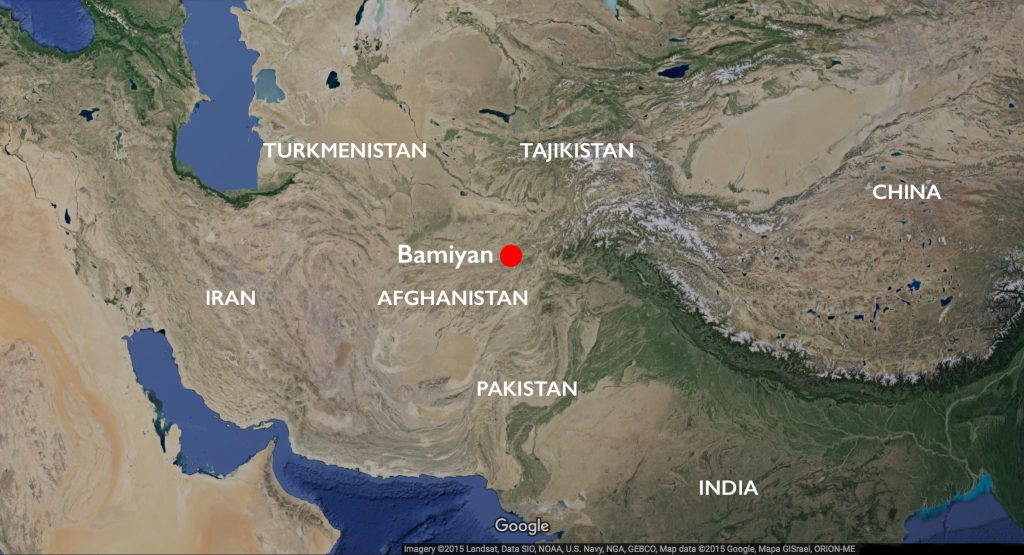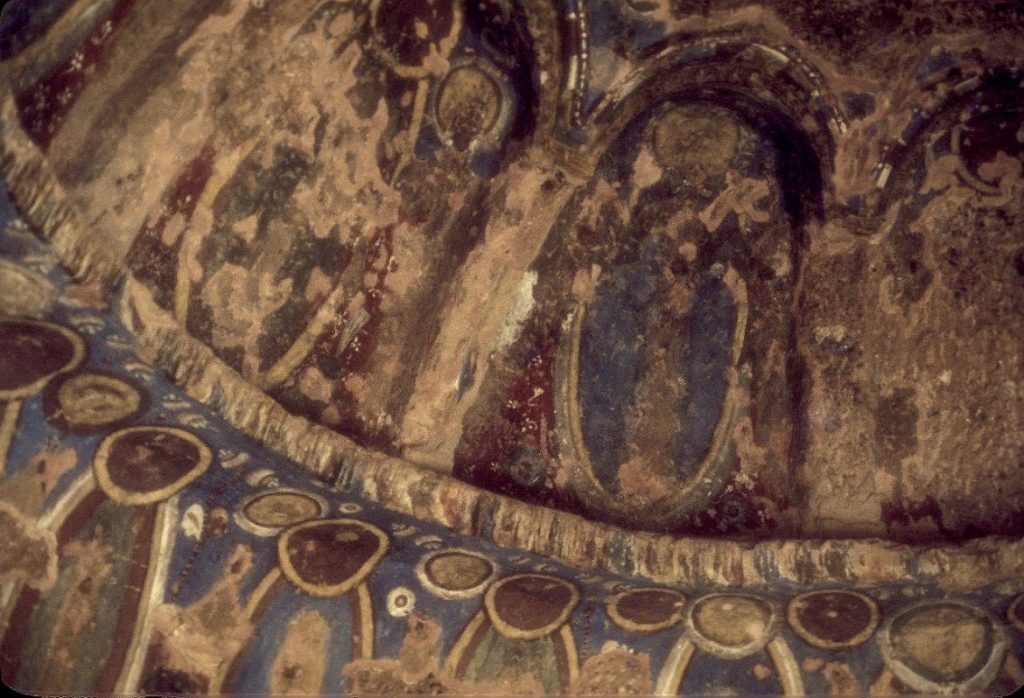ប៉ាមីយ៉ាន់ (Bamiyan) គឺជាតំបន់វប្បធម៌ និងក៏ជាស្ថានីយ៌បុរាណវិទ្យាដ៏សំខាន់នៅតាមតំបន់ជ្រលងភ្នំ គុស (Kush) ក្នុងខេត្តប៉ាមីយ៉ាន់ដែលស្ថិត នៅតំបន់កណ្តាលនៃប្រទេសអាហ្គានីស្ថាន (Afghanistan) ហើយមានចម្ងាយប្រមាណជាង ១០០គីឡូពីរាជធានីកាបុល (Kabul)។

ប្រភព៖ https://www.khanacademy.org , ទី ២ UNESCO
តំបន់នេះ គឺជាផ្លូវពាណិជ្ជកម្មដ៏សំខាន់មួយក្នុងបណ្តាញផ្លូវសូត្រ ដែលតភ្ជាប់ពីឥណ្ឌាទៅកាន់តំបន់មជ្ឍិមបូព៌ា និងចិនដោយឆ្លងកាត់តំបន់បុរាណ (បាក់តេរី) Bactria បច្ចុប្បន្នជាប្រទេអាហ្គានីស្ថាន និងជាតំបន់នៃការរីកចម្រើនខាងសាសនាដ៏ខ្លាំងក្លាមួយ ជាពិសេសព្រះពុទ្ធសាសនាតាំងពីស.វ.ទី១ ដល់ស.វ.ទី៩ និងសាសនាអ៊ីស្លាម។ ព្រះពុទ្ធសាសនានៅទីនេះ គឺទទួលឥទ្ធិពលពីសិល្បៈវប្បធម៌ Gandhara ដែលជាសិល្បៈព្រះពុទ្ធសាសនាដ៏សំខាន់ក្នុងតំបន់មជ្ឈិមបូព៌ា។
នៅតំបន់ប៉ាមីយ៉ាន់ ឃើញមានសំណង់ជាច្រើនដែលកសាងនៅលើជ្រលងភ្នំ គុស ដូចសំណង់ប្រាសាទ ប៉ុន្តែបច្ចុប្បន្នត្រូវបានខូចខាត ខ្លះនៅសល់តែគ្រឹះ និងខ្លះទៀត ស្ទើរបាត់រូបរាងទាំងស្រុង។ ជាពិសេសសំណង់ព្រះពុទ្ធរូបឈរចំនួនពីរអង្គ មានទំហំយ៉ាងធំ ហើយមានកម្ពស់ខ្ពស់ ដែលឆ្លាក់នៅជាប់នឹងជញ្ជាំងភ្នំ។ ពុទ្ធរូបមួយមានកម្ពស់ជិត៤០ម៉ែត្រ និងមួយអង្គទៀតមានកម្ពស់ជាង៥៥ម៉ែត្រ។ ទម្រង់ព្រះភក្រ័ និងភ្នួងសក់ គឺស្ទើរតែដូចទៅនឹងព្រះពុទ្ធនៅតំបន់ Gandhara។ សំណង់ពុទ្ធរូបទាំងពីរអង្គនេះ គឺកសាងនៅអំឡុងស.វ.ទី៦ និងទី៧ នៃគ.ស. ប៉ុន្តែនៅអំឡុងឆ្នាំ២០០១ ពុទ្ធរូបទាំងពីរអង្គ ត្រូវបានក្រុមសាសនាអ៊ីស្លាម (តាលីបង់) បំផ្ទុះបំផ្លាញទាំងស្រុង នៅសល់ត្រឹមតែស្លាកស្នាមនៃរូបរាងតែប៉ុណ្តោះ។ គួរបញ្ជាក់ដែរថា តំបន់ប៉ាមីយ៉ាន់ត្រូវបានផ្លាស់ប្តូរពីពុទ្ធសាសនាទៅអ៊ីស្លាមនៅអំឡុងស.វ.ទី១០ និងរហូតដល់ឆ្នាំ ២០០១ ទើបក្រុមសាសនាជ្រុលនិយមបានបំផ្លាញរូបនេះទាំងស្រុង និងក្រោយមកនៅឆ្នាំ២០០៧ តំបន់ប៉ាមីយ៉ាន់ត្រូវបានដាក់ចូលជាតំបន់បេតិកភណ្ឌពិភពលោក ដើម្បីការពារ និងជួសជុលរូបដែលបានខូចខាតឡើងវិញ។ ក្រៅពីសំណង់ពុទ្ធរូប នៅតាមជ្រលងភ្នំផ្សេងទៀត ក៏ឃើញមានរូបគំនូរ ដែលគូរពីព្រះពុទ្ធ ដូចនៅ Kakrak Valley Caves ដែលមានចម្ងាយប្រមាណជាង ៣គីឡូ ពីរូបធំទាំងពីរ។ រូបគំនូរនៅទីនេះភាគច្រើនមានអាយុកាលស្របាលគ្នានឹងព្រះពុទ្ធធំនោះដែរ (រូបលេខ ៧-៩)។

ប្រភព៖ www.nationalgeographic.com
នៅតំបន់ប៉ាមីយ៉ាន់ គេនិយមគូរ ឬឆ្លាក់ពុទ្ធរូបដែលមានទំហំធំ។ តាមរយៈសំណង់ទាំងនោះ អាចឱ្យអ្នកស្រាវជ្រាវយល់បានថា មនុស្សក្នុងតំបន់ វប្បធម៌ប៉ាមីយ៉ាន់ មានជំនាញ និងបច្ចេកទេសខ្ពស់ ក្នុងការកសាងសំណង់រូបបដិមាដ៏ធំទាំងនោះ។


ចាប់ពីស.វ.ទី ១០មក ផ្លូវពាណិជ្ជកម្មរវាងចិន និង ឥណ្ឌាត្រូវបានផ្លាស់ប្តូរចេញពីតំបន់ប៉ាមីយ៉ាន់ ដែលធ្វើឱ្យតំបន់នេះធ្លាក់ឥទ្ធិពលរបស់ខ្លួន ហើយចាប់ពីពេលនោះមកតំបន់នេះមានការផ្លាស់ប្តូរសាសនាពីពុទ្ធសាសនា មកអ៊ីស្លាមដែលចាប់ពីរាជស្តេចGhaznavid។
ជារួមមកតាមរយៈសំណង់ស្ថាបត្យកម្ម និងសិល្បៈ អ្នកស្រាវជ្រាវបានបង្ហាញពីការវិវឌ្ឍន នៃឥទ្ធិពលសាសនានៅក្នុងតំបន់វប្បធម៌ប៉ាមីយ៉ាន់ អំពីការកសាងព្រះពុទ្ធរូបដ៏ធំមហិមា រហូតដល់ការបំផ្លាញរូបទាំងនោះ ពីសំណាក់ក្រុមជ្រុលនិយមសាសនាអ៊ីស្លាមក្នុងប្រទេសអាហ្គានីស្ថាន។ ឥទ្ធិពលពុទ្ធសាសនាដែលមានការរីកចម្រើនក្នុងតំបន់នេះ គឺចាប់ផ្តើមពីស.វ.ទី១ ដល់ស.វ.ទី ១០នៃគ.ស. រហូតដល់ការជ្រាបចូលនៃសាសនាអ៊ីស្លាមចាប់ពីស.វ.ទី១០ រហូតដល់ពេលបច្ចុប្បន្ន៕
————————————
Bamiyan culture Landscape and Archaeological
Bamiyan is a cultural site and also an important archeological site in the Kush Valley in Bamiyan Province, located in central Afghanistan, more than 100 km from Kabul capital.
The region is an important trade route in the Silk Road network connecting India to the Middle East and China, passing through the ancient site of Bactria, which is now Afghanistan and a region of strong religious development, especially Buddhism from the 1st to the 9th century and Islam religious. In addition, Buddhism is influenced by Gandhara culture, which is an important Buddhist art in the Middle East.
In the Bamiyan region, there are many constructions built on the Kush Valley similar to the temples, but now some of them are damaged, only the foundations remain, and some have almost completely disappeared. In particular, the two standing Buddha statues are large and tall, carved on the mountain surface. One is nearly 40 meters high and the other is more than 55 meters high. The form of the face and the hair are almost identical to those of the Gandhara Buddha. Both Buddha statues were built during the 6th and 7th centuries. However, the two Buddha statues were completely destroyed by Islamist militants (Taliban) in 2001, and remain only traces of their appearance. It should be noted that the Bamiyan region was converted from Buddhism to Islam during the 10th century and until 2001 when extremist religious groups completely destroyed this statue. Later in 2007 Bamiyan was designated as a World Heritage site to protect and restore damaged Buddha statues. Besides, the Buddha statues in other valleys, there are also see the paintings of the Buddha, such as in the Kakrak Valley Caves, which are more than 3 km from the two large Buddha statues. Most of the paintings here are about the same age as the large Buddha statues. In the Bamiyan area, large Buddha statues are often painted or carved. Through these constructions, researchers can understand that the people in the Bamiyan cultural area have high skills and techniques to build these huge statues.
From the 10th century onwards, trade routes between China and India were diverted from Bamiyan, which undermined its influence, and since then the region has undergone a conversion from Buddhism to Islam during the Ghaznavid king’s reign.
Overall, through architecture and art, researchers have highlighted the evolution of religious influences in the Bamiyan cultural area with the construction of large Buddha statues that have been destructed of them by Islamic extremists in Afghanistan. In addition, the flourishing influence of Buddhism in this region dates from the 1st century to the 10th century until the penetration of Islam from the 10th century to the present.
អត្ថបទដើម៖ លោក អេង តុលា






